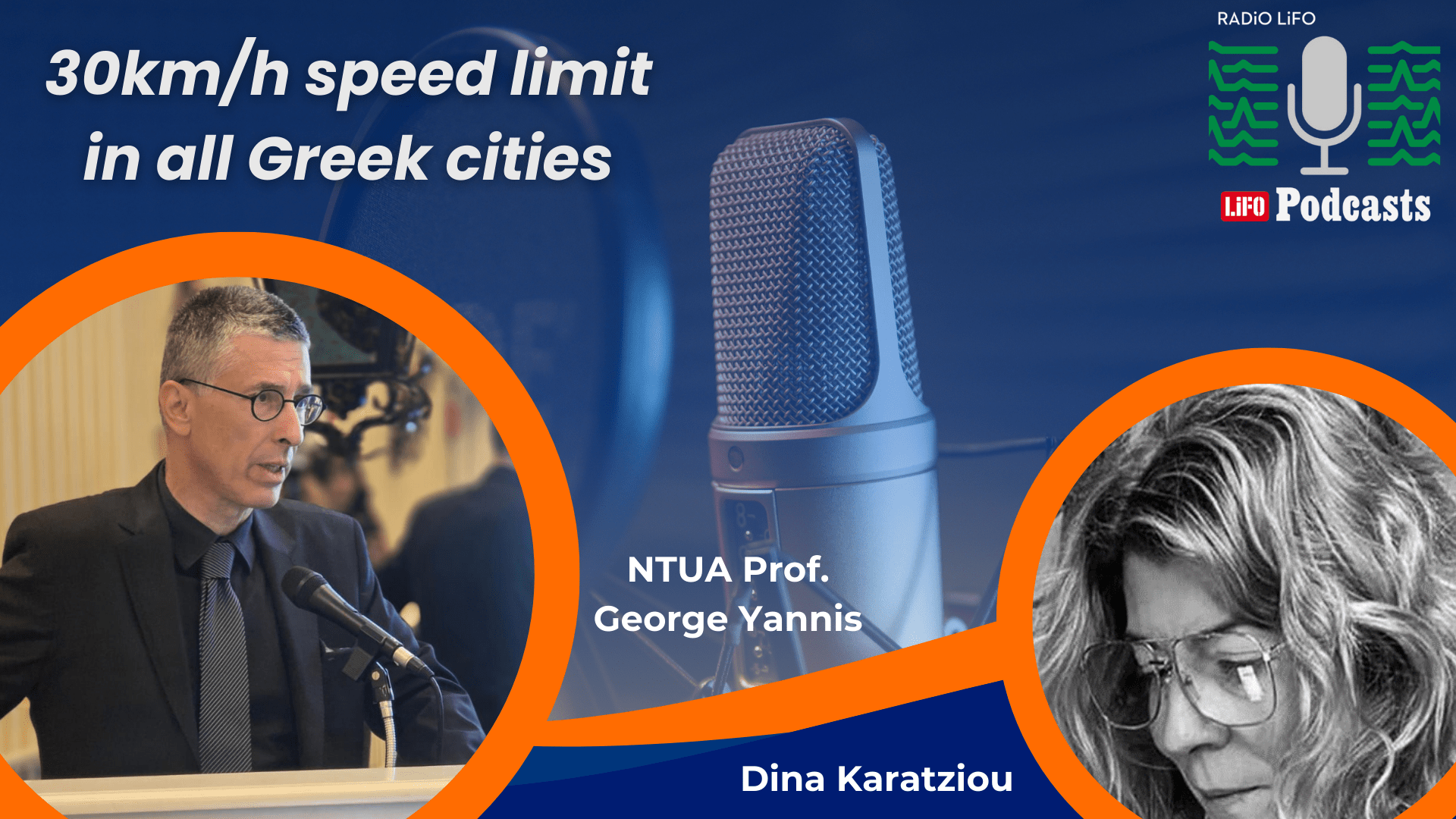How is road safety affected when the speed limit in urban areas is reduced to 30 km/h?
Since the pandemic, several cities in Europe and even an entire country, Spain, have adopted a citywide 30 km/h speed limit, of course with certain exceptions of main axes. It is a measure which, for the first time, brings such significant results at such a low cost. It is a catalyser for behavioural change, both for safety and urban mobility. Today, more and more cities are constantly considering and adopting this measure. Last year Amsterdam adopted it, as did the whole of Wales, and Greece is moving in the same direction, having already included it in its proposed new Road Traffic Code.
What are the findings of the studies on the impact of reducing the speed limit to 30 km/h in urban areas?
Over the past three to four years, we have collected valuable data from many European cities, analysing the impact of the 30 km/h speed limit in city centres. We have recently carried out the first comparative analysis between all these cities and the results are impressive. More specifically, the findings showed an average 37% reduction in fatalities in cities that implemented the 30 km/h limit. We also conducted a second comparative analysis of simulations of what would happen if the 30 km/h limit were implemented in the various European cities and similar results were obtained, with a 40% reduction in fatalities.
The results are solid and impressive. It is important to understand that the 37% average reduction in fatalities is mainly for pedestrians, cyclists and motorcyclists, who account for 70% of urban fatalities in Europe; these are the people we are saving with the 30 km/h limit. We should also highlight the ongoing debate among car drivers, who claim they feel safe travelling at 50 km/h; and they’re right. Serious crashes at 50 km/h in the city are rare for car drivers. However, the 30 km/h limit is not about protecting those inside the vehicle but those outside the vehicle. We are asking car drivers to go a bit slower in order to save the lives of those around them (pedestrians, cyclists, motorcyclists).
Implementing the 30 km/h limit could save up to 100 lives each year in Greece. From the approximately 650 annual road fatalities in Greece, this measure could significantly reduce that number in the coming years. It is, therefore, a crucial measure and should be supported and enforced in every way.
Does the 30 km/h speed limit affect travel time, or is that a myth?
It is purely a myth. Studies comparing data before and after the adoption of 30 km/h have shown a ± 2% change in travel time and average speed. In some cases, travel time increased slightly, while in others it decreased. The impact is negligible. This is easy to understand when you consider that, for example, in Athens and other cities, we rarely exceed 30 km/h during most of the day anyway. The only time we might travel faster is at night, when there is less traffic, but this is precisely when most crashes happen and that is when we will save lives. Therefore, traffic flow is not significantly affected, both the data and impact assessments confirm this. In fact, in cities where the measure has been in place for more than 2-3 years, traffic has actually improved after two years. Why? Because calmer traffic encourages more cyclists, pedestrians and public transport users to get out on the road, as they no longer fear cars. This shift reduces car use and traffic congestion. So, in the medium term, 30 km/h leads to better traffic conditions.
How will this measure be implemented in Greece? Is the approach of the new Traffic Code undaring?
To be clear, the current Government has recognized the problem, and the proposal to implement a citywide 30 km/h limit (with exceptions) is bold in itself. This alone will have a significant positive impact on road safety, an area in which Greece performs poorly as we are among the last positions in the EU27 ranking. We will see a dramatic improvement just from this measure alone. Beyond that, obviously, the impact also depends on how exactly this limit will be defined and enforced. As for its definition, the current proposal is somewhat timid, suggesting the limit only on one-way and single-lane roads. Many such roads already don’t exceed 30 km/h in practice. Based on evidence and what is done in other European cities, transportation engineers suggest that the 30 km/h limit should be applied to all roads without a median. If there is a median, which provides a relevant protection, the 50 km/h limit can remain on major roads where higher speeds can be safely developed. However, if there is no median, the speed should be limited to 30 km/h. There is a fundamental difference in safety if we put in a larger part of the road network.
Which roads will be excluded from the 30 km/h limit?
Major roads such as Alexandras Avenue, Kifisias, Mesogeion, and Vouliagmenis will be excluded, as they can more safely accommodate higher speeds. Each Municipality may conduct studies and designate specific roads that should remain at 50 km/h. However, the fundamental approach, as implemented in Spain, Wales and soon Ireland, is that all roads are initially designated as 30 km/h zones (with specific exceptions) and each Municipality can add more exceptions.
Is this measure compatible with the culture of Greek drivers? How will enforcement be ensured?
This is a matter of culture, safety and mobility. Cultural change begins with the Authorities. The Authorities quite rightly dare to set 30 km/h as the speed limit throughout the city and understand that this alone is not enough. They are already moving to purchase hundreds of speed cameras. Initially, 400 cameras are expected in Athens, eventually rising to 3,000 over the next year. It is impossible to have a police officer on every corner, but with cameras, we can enforce the 30 km/h limit and other traffic offences, like helmet use and red-light violations. Moreover, an additional goal is to automate fines through the gov.gr system, with violations being automatically detected and fines sent by SMS to the driver or directly to the tax Authority. This would encourage better compliance without the need for manual police processing.
We need to automate the system to ensure consistent enforcement, raise public awareness, influence driver behaviour and ultimately improve road safety. This system will be accompanied by something long overdue: the rationalization of traffic fines. For example, a fine of €50 for exceeding the limit by 10 km/h, and €350 for exceeding it by 50 km/h. It is a rationalisation that does not exist today, and if it is properly implemented, it will also help officers issue fines more easily and reduce resistance. At the same time, however, citizens will also better understand the consequences of speeding, helping to changing behaviour, improve road safety and reduce crashes in Greece.
What inspired the “30 Marathons in 30 Months” challenge?
As transportation engineers, we have been long conducting research and studies and advised both Greek and International Authorities as well as drivers and citizens on best practices. However, the scientific voice is sometimes flat, and it is not heard. As a Marathon runner since the age of 18, I decided to go beyond this dry academic language and pass the message across in a more original and creative way. This is the reason why I decided to run 30 Marathons in 30 months in order to actively promote the adoption of city-wide 30km/h speed limit in as many cities as possible worldwide, as a key policy for safer, healthier and greener cities. It is impressive to mention that while our scientific posts sometimes got around 500 reactions, Marathon-related posts reached over 100,000 reactions.
We have managed to raise awareness among a broader public audience, receiving messages from across Europe and globally. The campaign had a great impact all over Europe, including France, Spain, Belgium, Portugal, and elsewhere and was widely promoted by the media. Today, scientific communities around the world, especially in Europe, make reference to both our research and the Marathons. I successfully run and finished all 30 Marathons under 4 hours last November and I continue running Marathons, promoting 30km/h speed limit and advocating for safer cities.
Can the interactive dashboards from the NTUA Safety and Mobility Observatories help address Athens’ traffic congestion? Is there a solution?
At NTUA, our role is to provide evidence-based decision support and sustainable solutions. We observe what works in comparable cities and propose what should be done in Greece. Monitoring data shows that traffic in Athens is continuously deteriorating and trends suggest it will worsen significantly unless serious action is taken. However, Greece suffers from administrative fragmentation: Municipalities, Authorities, Ministries and the Traffic Police should all agree on any measure and they rarely sit at the same table. This is a major obstacle.
But the key understanding is that, as in other European cities, there is no solution to the traffic problem. For decades, we know the traffic point of balance is at congestion; however there is a solution for better traveller service and better mobility conditions. If we take the right measures and rely on public transport for long trips and walking, cycling, or scooters for short ones, we can significantly improve service levels, just as other cities have done. Some Greek cities have made progress through serious effort. Athens, Thessaloniki and other large cities need to follow.
What is the role of public transport and parking?
Priority should certainly be given to Public Transport, with more systematic enforcement of bus lanes, more and better buses and expanded metro infrastructure in the long-term. In addition, a comprehensive approach to managing properly public space and parking is essential. We should stop handing over entire streets to parked cars. Parking policy is the most effective tool for managing traffic and congestion. If we make sure that we have a proper parking policy, especially in the central areas with reduced on-street parking, we will attract fewer cars and have less congestion and increased demand for buses and public transport. While the science of transport engineering may seem simple, it involves integrating many puzzle pieces and requires expertise. It is time for the Authorities to approach the issue holistically and seriously, because so far they has been largely absent. With just a bit of effort, we could see positive changes within 1-2 years, and within 4-5 years, our cities could begin to resemble to the best urban examples in Europe.
Podcast in Lifo with Dina Karatziou, in May 2025

